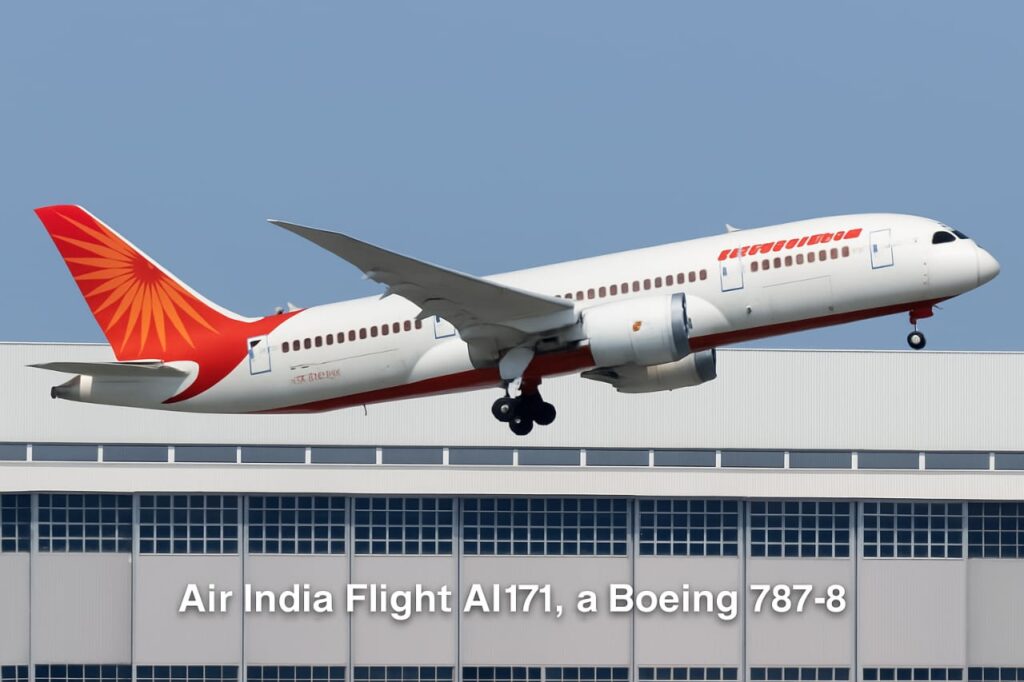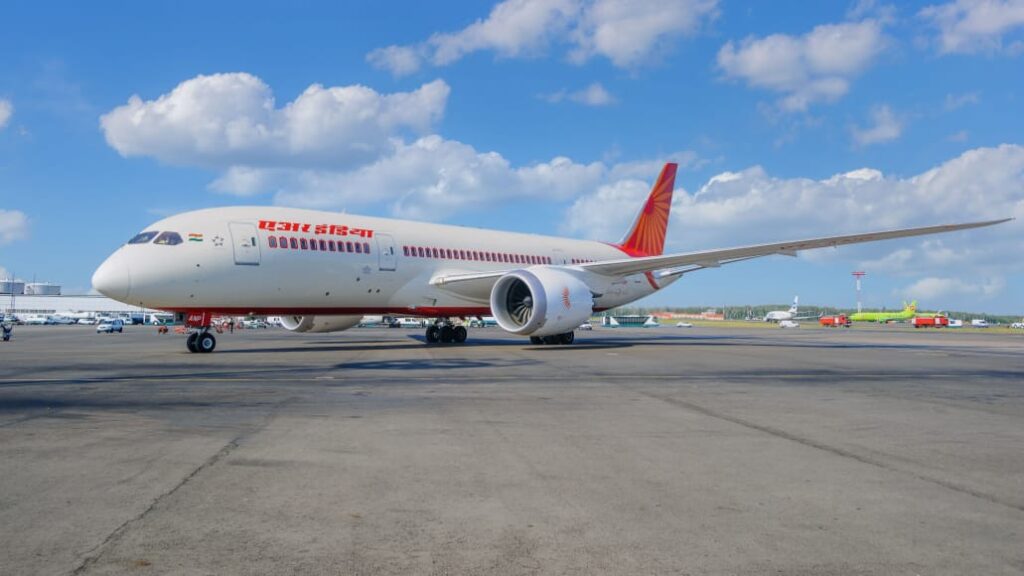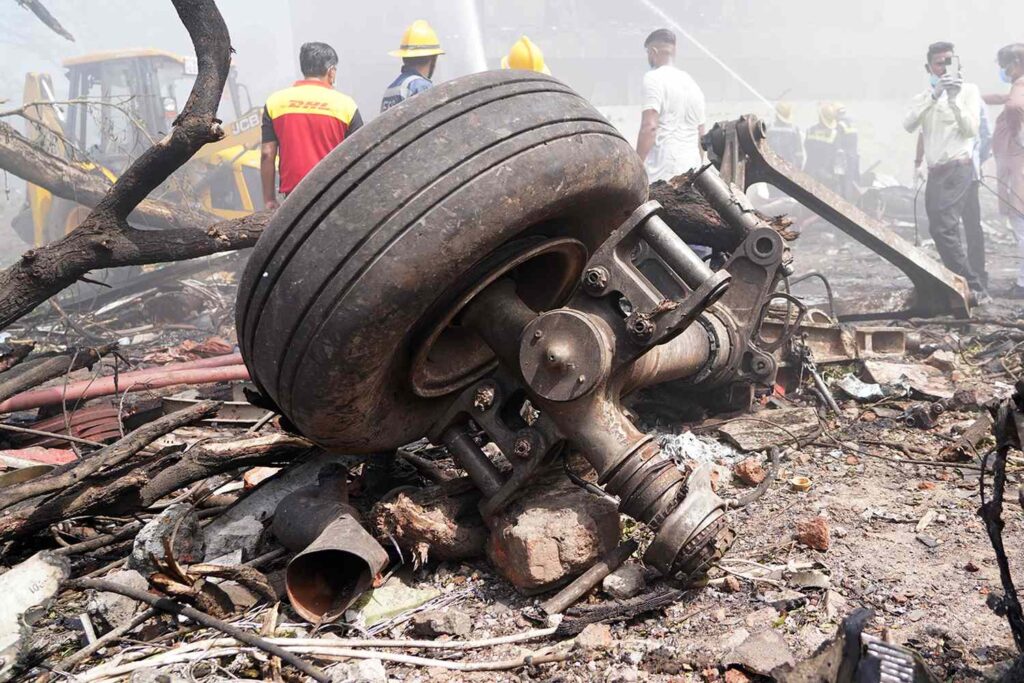
🔍 Introduction
The Air India AI171 crash on June 12, 2025, is one of the deadliest aviation tragedies in India’s recent history. As the official preliminary investigation report by the Aircraft Accident Investigation Bureau (AAIB) was made public, it has sparked more questions than answers.
At the heart of the controversy lies a chilling possibility: Are the deceased pilots being blamed unfairly to protect Boeing’s reputation and design flaws? This blog explores the technical, ethical, and political angles of the Air India AI171 crash with a focus on truth, transparency, and accountability.
✈️ What Happened on Air India AI171 Crash? A Quick Recap
Air India flight AI171, a Boeing 787-8 Dreamliner, departed from Ahmedabad bound for London Gatwick. Just 30 seconds after takeoff, the aircraft nosedived into a medical college building, resulting in 260 deaths, including passengers, crew, and civilians on the ground. Only one passenger miraculously survived.
What caused this horrifying event?
According to the preliminary AAIB report, both fuel cutoff switches were moved from “RUN” to “CUTOFF” — effectively shutting down both engines mid-air. The cockpit voice recorder captured a panicked exchange between the two pilots:
- Pilot 1: “Why did you cut off?”
- Pilot 2: “I did not do so.”
The engines failed. The aircraft lost all thrust. The plane crashed.
But here’s the question that’s not being answered clearly:
Why were those switches flipped? And by whom?
INS Tamal: A New Chapter in Indian Naval Power
🧠 Are the Pilots Being Unfairly Blamed?
Blaming dead pilots is not new in aviation history. What raises suspicion in the Air India AI171 crash is the implied cause without hard evidence. The report indirectly points toward human error — specifically, one of the pilots switching off the fuel supply during takeoff.
Let’s unpack why this explanation feels incomplete — and potentially manipulative.
1. 🎚️ Fuel Cutoff Switches Are Hard to Accidentally Activate
- Boeing’s 787 design makes these switches guarded to avoid accidental toggling.
- They require intentional manual movement, sometimes even unlocking mechanisms.
- Why would an experienced pilot switch them off during critical seconds of takeoff?
This raises two possibilities:
- A mechanical/electronic fault triggered the switches.
- Or, there was a confusion/mix-up under pressure — again, pointing to poor cockpit design and lack of safeguards, not necessarily negligence.
2. 🧑✈️ Dead Pilots Can’t Defend Themselves
With both pilots killed in the Air India AI171 crash, there’s no counter-narrative. No defense. No explanation.
The risk here is scapegoating — creating a neat answer for the media, public, and lawsuits. But the truth may be more complex and uncomfortable.
3. 🏢 Protecting Boeing’s Image (Again?)
Boeing has a long history of minimizing its own faults. The 737 MAX crashes in 2018 and 2019 killed 346 people. Initially, Boeing blamed pilots and poor training — only to later admit the MCAS system design was deeply flawed.
In the Air India AI171 crash, investigators note that Boeing and Air India did not implement the FAA’s 2018 advisory, which recommended inspecting fuel switch safety mechanisms. While it wasn’t mandatory, should such a critical component remain unchecked?
If Boeing failed to enforce a safety change, and Air India skipped the update — is it still fair to suggest the pilots made a mistake?
💰 Boeing’s Billion-Dollar Business & The Question of Influence in Indian Aviation
When a global tragedy strikes — especially in aviation — we often look at technical failures, human errors, or regulatory gaps. But what if the real cause is deeper, darker, and heavily protected by money?
Let’s talk numbers. Let’s talk power. And let’s talk the uncomfortable possibility of money shaping investigation narratives.
💸 How Much Does Boeing Earn from One Aircraft?
The aircraft involved in the crash — the Boeing 787-8 Dreamliner — is one of Boeing’s most successful wide-body commercial planes.
| Aircraft | Price (Approx.) | Earnings Per Unit |
|---|---|---|
| Boeing 787-8 Dreamliner | ₹1,500 crore (approx. $180–200 million) | High-margin profit, especially on bulk sales |
Inside Assam’s Coal & Supari Syndicate – Full Crime Report
Air India’s order of 787 Dreamliners was part of a massive expansion deal. India remains a key customer base for Boeing in Asia.
Boeing has already earned billions of dollars from orders placed by Indian carriers — including Air India, Vistara, Akasa Air, and more.
This makes one thing clear: Boeing has a lot to lose if its aircraft are labeled “unsafe” or if systemic flaws are exposed. One public relations disaster could mean cancelled contracts, lawsuits, and global mistrust.
🏦 What If ₹100 Crore Can Shape the Narrative?
This is speculative — but not impossible.
India has a long history of corruption in government, regulatory, and corporate systems. We’ve seen it in:
- Defense deals
- Telecom licenses
- Infrastructure contracts
- Public safety inspections
If a company with unlimited global resources like Boeing wanted to “manage” a situation, here’s how ₹100 crore (around $12 million) might be used:
- To influence bureaucrats or senior officials in civil aviation, accident investigation bodies, or ministries.
- To delay or dilute safety inspection reports.
- To frame preliminary conclusions in a way that shifts responsibility from Boeing to pilots or airline operations.
- To sponsor favorable media coverage that reduces outrage or changes public opinion.
India’s watchdog agencies have often been criticized for weak enforcement. In a country where bribes can alter tenders, licenses, and even criminal cases, the idea that a powerful multinational might influence an accident report is not just possible — it’s probable.
👥 Conflict of Interest: Who Watches the Watchdog?
Consider this:
- If AAIB, DGCA, or other regulatory agencies depend on foreign manufacturers for data, access, or training, they’re no longer neutral.
- If retired officials or consultants working for Boeing also sit on Indian advisory panels, that’s a conflict of interest.
- If politicians benefit from Boeing-related investments in India’s aviation growth, would they really allow the truth to jeopardize business?
This isn’t about making wild accusations. It’s about acknowledging how money, politics, and power can sometimes shape the truth we’re told.

📣 Final Reflection: The Price of Silence
Imagine this — a ₹1,500 crore aircraft crashes, 260 lives are lost, and the only people blamed are two dead pilots who cannot speak. Meanwhile, the manufacturer walks away untouched, signs new billion-dollar deals, and the cycle continues.
If Boeing — or any company — can spend a small fraction of their profits to protect their brand, wouldn’t they be tempted?
As citizens, consumers, and truth-seekers, we must ask:
“If ₹100 crore can rewrite an official report, what is the value of 260 lives lost?”
🛑 What If the Fault Lies in the Design?
Let’s look at design flaws as a possible root cause.
❓ Could the Fuel Switch Be Vulnerable to Interference?
Experts have suggested:
- Static electricity or short circuits can cause switch anomalies.
- Poor wiring or software bugs can simulate manual inputs.
- Cross-linking between cockpit systems in the 787 can confuse logic paths under stress.
Without cockpit video (currently not mandated), it’s impossible to know who actually moved the switches — or if they were moved at all by human hands.
❗ The FAA Safety Bulletin Was Ignored
In 2018, the U.S. Federal Aviation Administration (FAA) warned about potential safety hazards in Boeing fuel cutoff switches — specifically urging inspections and design reviews. But it was classified as an advisory, not mandatory.
Air India, like many carriers, did not act on it. Boeing did not redesign the mechanism.
So when both engines shut down on AI171, could the ignored advisory have become the root of the disaster?
🧾 DGCA and AAIB: Transparency or Cover-Up?
🕵️♂️ Investigative Delays and Lack of Access
Critics argue:
- The AAIB report was released a month late.
- The data logs are not fully published.
- The pilot association was not included in the investigation committee.

This lack of transparency only fuels the theory that a cover-up may be underway to protect Boeing’s global standing and reduce legal liabilities.
✊ Pilots’ Union Pushback
The Airline Pilots’ Association of India has condemned the preliminary report, calling it:
- “Presumptive in blaming the pilots”
- “Lacking technical transparency”
- “Possibly politically influenced”
They demand:
- Third-party review
- Representation in the inquiry process
- Access to raw black box data
Their question is simple:
Why rush to frame the pilots when deeper investigation is still underway?
🧩 A Pattern of Negligence: Not Just One Flight
Let’s zoom out. This is not just about one crash.
Across aviation history, we’ve seen:
- Boeing ignore early warnings.
- Regulators delay mandatory fixes.
- Airlines avoid costly updates.
- And pilots blamed — only to later be vindicated.
The Air India AI171 crash could become another chapter in this troubling book — unless independent reviews, international observers, and technical transparency are introduced immediately.
🧠 Critical Questions We Must Ask
- Why were the fuel switches moved, and by whom?
- Were electrical or software faults possible?
- Why were FAA advisories ignored by Boeing and Air India?
- Why no cockpit video recordings in such modern aircraft?
- Can a manufacturer’s design flaw be protected at the cost of pilot reputations and passenger safety?
✅ What Needs to Happen Next
| Action | Why It Matters |
|---|---|
| ✈️ Mandate cockpit video recorders | To confirm pilot actions and prevent assumptions |
| 📋 Convert FAA advisories into enforceable mandates | So safety updates aren’t optional |
| 🧪 Full third-party audit of Boeing 787 systems | For impartial technical validation |
| 👨⚖️ Legal representation for families & pilot unions | To balance the narrative and challenge assumptions |
| 📢 Transparency in final AAIB report | So the public receives the full truth |
📌 Conclusion: Let the Dead Speak Through Truth
The Air India AI171 crash took 260 lives. If even one life could have been saved by a design change, a training update, or a stricter inspection, then blaming the pilots alone is not just wrong — it’s dangerous.
This blog does not claim to know the full truth. But it insists on asking the hard questions — before blame is finalized and the case is closed.
In aviation, trust is everything. And if corporate negligence or cover-ups silence that trust, we must speak louder.
🙋 Final Note
If you’re a reader, a flyer, or someone who lost a loved one in Air India AI171 crash— demand accountability. Not just from pilots who are no longer here to speak — but from those who built, flew, and certified the aircraft.
Only then can we say we’ve honored the victims — with truth, not blame.
🌄 Plan Your Trip to Northeast India with Us!
Want to explore the untouched beauty of the Northeast?
From the misty mountains of Mizoram to the living root bridges of Meghalaya, and the cultural heart of Assam — we’ve got you covered!
✅ Personalized Travel Itinerary
✅ Local Guides & 24/7 Support
✅ Best Hotel & Homestay Options
✅ Group Tours & Solo Packages
✅ Affordable, Safe & Hassle-Free
📩 Contact us today and let’s start planning your dream trip!
📞 Call/WhatsApp: 8453980642
🧳 Book your Northeast adventure now – Discover places you’ve only dreamed of!
